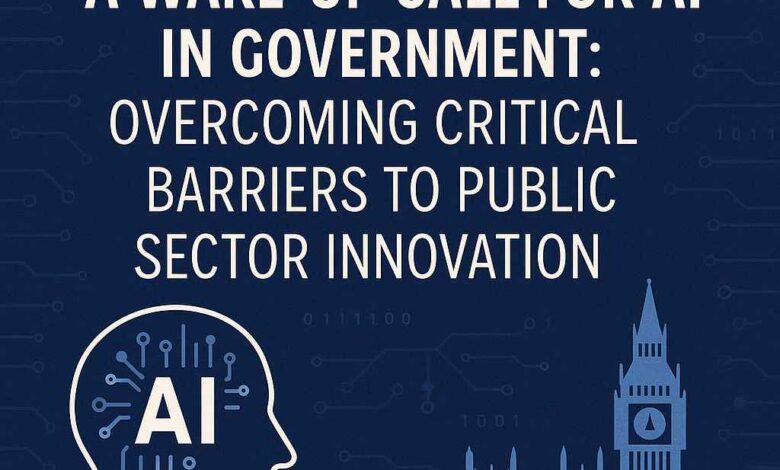
The recent “Use of AI in Government” report from the Public Accounts Committee (PAC) has concluded that despite AI’s revolutionary promise, government adoption is fraught with difficulties.
Prime Minister Sir Keir Starmer has said AI has “vast potential” for rejuvenating UK public services and the government announced in January its plans for an AI Opportunities Action Plan to “unleash AI” across the UK to try to boost economic growth.
But if the UK wants to take advantage of AI’s potential to boost efficiency and improve public services, the findings serve as a timely wake-up call that requires immediate attention.
Legacy systems are holding back innovation
Outdated infrastructure is cited in the committee’s report as a key barrier. This is consistent with a study SAS commissioned in 2024, surveying 170 civil servants across all major government departments, which found that 69% of public sector organisations see outdated infrastructure and legacy systems as the top obstacle to deploying AI.
The architecture of these aging systems has resulted in a technical debt that is growing every year. It’s clear that the Government must modernise strategically, striking a balance between short-term operational requirements and long-term objectives for digital transformation.
This calls for careful integration that creates links between historical infrastructure and emerging AI capabilities rather than the complete replacement of current systems.
The data challenge: Fragmentation and quality issues
Meanwhile, the availability of high-quality, representative data is essential to AI’s efficacy. However, the committee’s report highlights serious obstacles to data accessibility and departmental sharing, a problem that our research also found to be crucial.
Across many large organisations, including government, data silos lead to inefficiency and lost chances for cross-departmental insights. This also has the potential to erode public trust in AI. Even the most advanced AI systems will not deliver on their promise if fundamental data problems are not resolved.
There is positive news here, though, with almost three-quarters (74%) of civil servants now sharing data with other departments according to our research. That’s an increase of five per cent since 2022 and reflects a positive shift and a growing appreciation for the benefits of data sharing, such as improved service delivery and better decision-making.
Synthetic data (algorithmically generated data that mimics real-world data and which is a product of generative AI) could also have a significant role to play, enabling teams to generate data when real-world data is either unavailable, of low quality or can’t be used for privacy or security reasons.
Addressing the critical AI skills gap
The committee’s findings relating to the skills gap in government are arguably the most concerning. This was echoed in our research with 48% of civil servants citing a ‘lack of internal technical knowledge or expertise’ as a barrier to implementing AI or analytics initiatives.
From technical professions that create and manage AI systems to leadership roles that direct strategy deployment, there is a skills shortage at many levels. A multifaceted strategy is needed to build this capability, including upskilling current employees, hiring specialised expertise and establishing strategic alliances with academic institutions and technology companies.
Developing AI and digital literacy in non-technical employees who will collaborate with these systems is equally important. The government has acknowledged that one in 10 civil servants will work in technology and digital roles within the next five years, with 2,000 technology apprenticeships being lined up to turbo-charge this transformation.
Creating a responsible framework for public sector AI
As the committee’s report correctly points out, strong governance mechanisms are necessary too, to guarantee that AI systems are used responsibly. Transparency, equity and accountability must be given top priority when implementing AI in the public sector, especially when decisions affect vulnerable groups or vital services.
The Government Digital Service has already committed to updating its Data Ethics Framework, which helps public sector teams deliver data projects in a responsible, fair, and transparent way.
Building public confidence in government AI programmes will be essential and must be facilitated by creating explicit ethical standards tailored to public sector applications. To guarantee that systems operate as intended without prejudices or having unforeseen implications, these frameworks should incorporate procedures for continuous monitoring and assessment.
The economic imperative: ROI and public value
Beyond the organisational and technological difficulties, the PAC report discusses proving a definite return on investment.
When surveyed, an interesting perspective from one senior manager from the Department for Work and Pensions suggested having “a requirement to make a business case against sharing [data] rather than for it.”
This underlines that many civil servants find it difficult to quantify the business case for implementing AI, which makes it challenging to get the required funds and support from stakeholders.
This problem is keenly felt in the public sector, where many factors including social impact and service quality are considered success criteria in addition to financial returns. For AI to be implemented sustainably, comprehensive frameworks to assess its effects across several aspects must be developed.
Before implementing solutions more widely, government agencies should think about pilot projects with well-defined success indicators. While producing data to encourage broader adoption, these controlled implementations offer worthwhile learning opportunities. Transparently recording both achievements and setbacks is critical to develop institutional knowledge which improves future strategies.
Beyond operational effectiveness, there are wider societal benefits from the use of AI in government. AI allows public workers to concentrate on complex problems that call for human judgment and empathy. This will likely improve work satisfaction and retention in vital public sector positions in addition to improving service performance.
Moving forward: Collaborative innovation
Despite some of these challenges there is a strong commitment within the government to seize the AI opportunity. Through cooperative strategies that include government agencies, technological partners and academic institutions, the committee’s report offers a chance to methodically address these obstacles.
Government departments should aim to respond to Select Committee reports within two months of their publication, so it will be interesting to see how things develop.
Although the Central Digital and Data Office’s efforts to develop cross-government standards are a start in the right direction, their implementation needs both committed leadership and specialised resources. Establishing centres of excellence where departments can exchange best practice could speed up development and save duplication of effort.
From wake-up call to action
The PAC report serves as a reality check that can also inform how the government delivers its AI roadmap.
AI has the potential to revolutionise government services, increase operational effectiveness and eventually improve citizen outcomes with careful planning and sufficient funding. This could help tackle some of the government’s most pressing issues, including the challenge facing The Chancellor to find savings in government spending.
But what we need is a well-rounded strategy that acknowledges the particular difficulties of public sector implementation while embracing innovation. Effective delivery of the AI Opportunities Action Plan will be key to this.
The opportunity is obvious; now, we must acknowledge and respond positively to this wake-up call and create genuinely intelligent public services for the future.





